Introduction
Korean agriculture has been facing many challenges including its sluggish growth opening of market, climate change, and energy and resource shortage problems. Korean government has continually expanded investments in agri-food sector’s R&D to give appropriate solutions to these challenges and hopefully lead to agricultural growth. This article introduced and reviewed the R&D activities and system for agri-food in Korea.
Present situation
Three organizations such as the Ministry of Agriculture, Food and Rural Affairs (MAFRA); the Rural Development Administration (RDA); and the Korea Forest Service (KFS) regularly conduct R&D investments for the agri-food sector. R&D budget for MAFRA, RDA and KFS has increased annually by 7.7% while that of the national R&D budget has gone up by 8.2% in the recent seven years. In the meantime, the total expense of MAFRA, RDA and KFS has increased annually by 2.7% during the same period from 2008 to 2014.
Table 1. Share of R&D Budget of Ministry of Agriculture, Food and Rural Affairs, Rural Development Administration, and Korea Forest Service
Unit: 100 million won
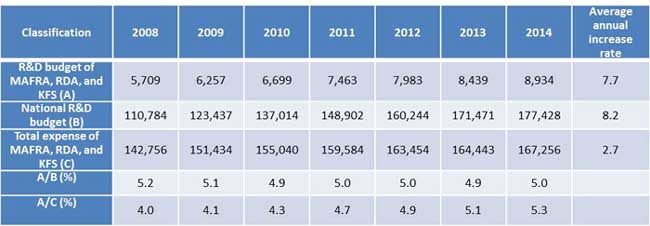
Another characteristic of R&D investments area in the agri-food sector is that instead of the private sector, it is the public sector which is the main investor of R&D for agri-food.
In 2012 the total domestic R&D investments is about 55.45 trillion won, which included the private sector’s investments, among them R&D investments regarding food, agriculture and forestry which accounts for 2.3% (1.25 trillion won).
The R&D expenditure in the agri-food sector which is owned by private enterprises was 424.9 billion won. This accounts for 33.9%, and its share was smaller than that of the public research institute which accounts for 540.8 billion won (43.2%). We can say that the share of R&D expenditure by private enterprises is very low in the total R&D expenditure of the nation in 2012 (424.9 billion won of the total 55.4 trillion won).
The present status of domestic R&D investments in the agri-food sector in regard to the seven related sectors of the First Comprehensive Plan show that the biotechnology sector. (of which investments expanded most from 2009 to 2012), increased by 29% in annual average.
Table 2. Variations of agricultural R&D investments in seven major sectors
Unit: 100 million won, %
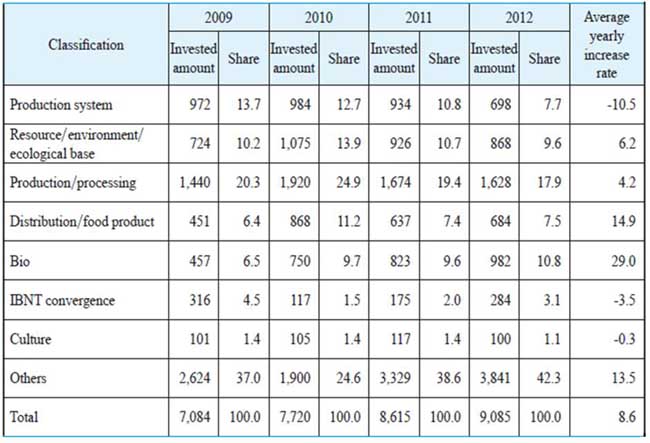
Note: The amount includes investment in fishery products.
Source: Korea Institute of Planning & Evaluation for Technology in Food, Agriculture, Forestry & Fisheries.
R&D focus and core technologies
In 2013, there were three main organizations related to R&D investments which got involved in the agri-sector. They are the Ministry of Agriculture, Food and Rural Affairs, the Rural Development Administration, and the Korea Forest Service. Recently these organizations announced the “Mid-and-Long Term plan for Agri-food Science & Technology Development (2013-2022)” with four major R&D areas evaluated in order to 1) increase global competitiveness, 2) create a new growth power, 3) supply food in a stable manner, and improve national welfare. Like the opening of the Korean agricultural market and climate change, the plan reflected the R&D environment, and the philosophy of the Korean agricultural policies which basically aims to achieve a creative economy and maximize the utilization of the Korean people.
Strengthen the global industrial competitiveness
The aim of strengthening the global industrial competitiveness is to be more competitive by developing a technology-intensive and ICT-based agri-food industrial sector.
|
Aim of plans
• Agri-food Exports Increase: $5.6 billion in 2012 → $10 billion in 2017→ $15 billion in 2022
• Added Value: 56 trillion in 2012→ 67 trillion in 2017 → 77 trillion in 2022
|
For that, investments will be concentrated on developing technologies to strengthen the industrial competitiveness to prepare a liberalized Korean agricultural market by the 45 FTAs in 2013 and be more competitive in the global market. Technologies have to be developed & updated to promote welfare (including health) of the public by liking the agricultural and livestock industry to the food industry, and technologies that are smart, automated, and converged with ICT to address the problems caused by decreasing rural population and increasing agricultural management costs.
Table 3. Core technologies to strengthen global industrial competitiveness

Find other ways for growth
The passion to seek a creative way for growth will be able to help create new markets by developing a new material industry which is agri-based. In this way, people will be able to appreciate the goals of agricultural development: to create an eco-friendly environment and increase the quality of life. In the process another goal is to become a powerful nation in the energy sector via developing and industrializing energy through agriculture.
For that, the government has to conduct the establishment of a system which produces technology support which can cover all of the sectors, so they can contribute to the promotion of the agricultural and bio-industry such as agricultural genome, new biological materials and bio-food and drugs.
|
Performance Targets
• Domestic production in the new biological material industry:
10 trillion in 2012 → 15 trillion in 2017 → 20 trillion in 2022 (100%↑)
• Renewable energy:
73,000 TOE in 2012 → 618,000 TOE in 2017 → 1,163,000 TOE in 2022 (1,493%↑)
∙ Share of biomass in the total energy production: 10% in 2022
|
Table 4. Core technologies to accelerate growth
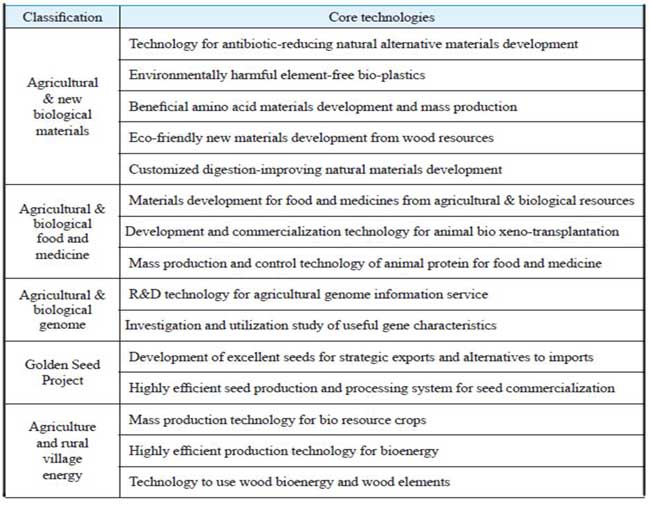
Stable food supply
To achieve a stable food supply, those, who work in related R&D investments in the agri-sector, have to develop programs that will promote a sustainable agriculture industry that can endure climate change. It also needs foundation for safety of livestock production through the establishment of a strict immune system for livestock.
|
Performance targets
• Reduction in greenhouse gas emissions: 0% in 2012 → 7.1 % in 2022
• Securement of a position as an infectious livestock disease-free nation
|
For that, the government has to focus and invest in order to develop technologies that would enhance productivity and quality of grains, addressing issues like unstable amount of supply and demand of crops and food resources.
Table 5. Core technologies for stable food supply
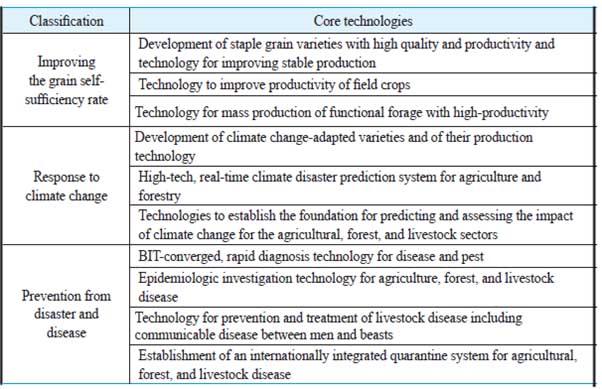
Plus, the government should enhance technologies to address issues like uncompetitive crop productivity. It also needs to seek suitable farmlands to prepare for climate change and global warming.
Improve the nation’s welfare
The aims to improve the national welfare are to reform the countryside into better working and resting places via reinventing those regions, to promote urban farming where agricultural resources such as livestock and foodstuffs co-exist, and to establish the foundation that works to produce, manage and provide a stable supply of safe agri-food.
|
Performance targets
• Rural residents’ satisfaction level for the quality of life: 50 points out of 100 in 2012 → 60 points in 2017 → 65 points in 2022 (30%↑)
• The number of beneficiaries of forest welfare services: 11 million in 2012 → 20 million in 2017 → 30 million in 2022 (172%↑)
• Construction of urban forests in living zones: 8㎡ per person in 2012 → 9㎡ in 2017 → 10㎡ by 2022 (25%↑)
• Agricultural/livestock produce with environmentally friendly certification:7%/12% in 2012 → 9.5%/15% → 12%/20% in 2022
|
For that, government tried to push its efforts not just to develop technologies that help increase incomes. In the non-farm sector, the government also made efforts to preserve the traditions of rural communities and promote the urban conditions through the development of certain agricultural disciplines like landscaping.
Table 6. Core technologies for improvement of national welfare
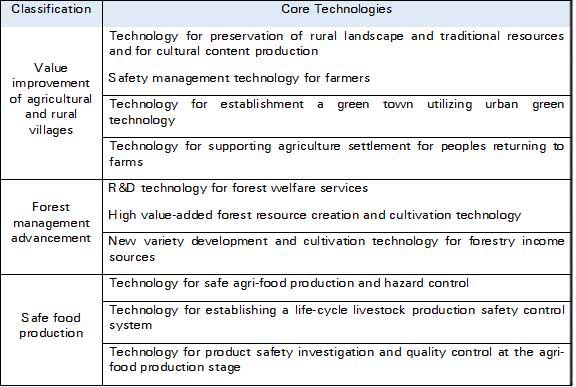
Main achievements of R&D policies in agri-food sector
There are several achievements that R&D investments has set out in the agri-food sectors. They are as follows:
First, thanks to increased investments in the agri-food R&D, the level of technologies in the sector has been enhanced. While the total amount of budget in the agri-food sector increased by 2.7% in the recent seven years (2008-2014), the budget for R&D expanded by 7.7%, which is an annual average amount, in the same period. The share of R&D has been raised generally in related sectors.
Second, the groundwork which aims to create a more effective R&D through policies related to groundwork has been improved. The Office of Strategic R&D Planning for Climate Change was set up in 2011 and followed joint surveys about demand for technology based on the groundwork. The objective is to make effective R&D investments.
Third, a system for commercializing technology was created throughout the whole stages-- from an R&D commencement and intellectual property protection acquisition stage to a technology transfer and trade stage, to a market entry and maturity stage. The private investments environment for R&D by agri-food companies was created by expanding projects to commercialize technology and by introducing the “R&D fund.” Early commercialization of technologies was achieved through expanding opportunities for private enterprises to participate in R&D projects which was carried out by the government. The participation rate of private companies in the national R&D projects for agri-food areas increased from 25% in 2012 to 32% in 2013.
Conclusion and Policy Implication
Despite these achievements, many problems exist in the R&D of agri-food in Korea as follows: shortcomings in linkages between agri-food policies and R&D; limitation of the Science and Technology Commission of Food, Agriculture, and Forestry as a control tower that leads to innovations in agri-food science and technology; limited investments of private organizations and companies in R&D; the weak regional base for R&D; insufficient research for convergence with ICT, BT, and NT; and unsatisfactory level of and immature conditions for commercialization of technologies.
Finally, in order to overcome these problems in R&D of agri-food and maximize these achievements, the government has to efficiently develop and use food, agriculture, and forest resources by establishing infrastructure for the development of science and technology and work out systematic measures to facilitate the sound development of the food, agricultural, forestry industries and create a better quality of life for the public.
Reference
Korea Institute of Planning & Evaluation for Technology in Food, Agriculture, Forestry and Fisheries. Website. (http://eng.ipet.re.kr/)
Lee Myeonggi et al. 2014. Measures to Improve Agricultural R&D Governance Efficiency and Expand Private Investment (Year 1 of 2), Korea Rural Economic Institute.
__________________. 2015. Measures to Improve Agricultural R&D Governance Efficiency and Expand Private Investment (Year 2 of 2), Korea Rural Economic Institute.
Ministry of Agriculture, Food and Rural Affairs. 2013. Mid- and Long-term Plan for Agri-food Science & Technology Development (2013-2022).
|
Date submitted: April 11, 2016
Reviewed, edited and uploaded: April 12, 2016
|


R&D Policy for Agri-Food in Korea
Introduction
Korean agriculture has been facing many challenges including its sluggish growth opening of market, climate change, and energy and resource shortage problems. Korean government has continually expanded investments in agri-food sector’s R&D to give appropriate solutions to these challenges and hopefully lead to agricultural growth. This article introduced and reviewed the R&D activities and system for agri-food in Korea.
Present situation
Three organizations such as the Ministry of Agriculture, Food and Rural Affairs (MAFRA); the Rural Development Administration (RDA); and the Korea Forest Service (KFS) regularly conduct R&D investments for the agri-food sector. R&D budget for MAFRA, RDA and KFS has increased annually by 7.7% while that of the national R&D budget has gone up by 8.2% in the recent seven years. In the meantime, the total expense of MAFRA, RDA and KFS has increased annually by 2.7% during the same period from 2008 to 2014.
Table 1. Share of R&D Budget of Ministry of Agriculture, Food and Rural Affairs, Rural Development Administration, and Korea Forest Service
Unit: 100 million won
Another characteristic of R&D investments area in the agri-food sector is that instead of the private sector, it is the public sector which is the main investor of R&D for agri-food.
In 2012 the total domestic R&D investments is about 55.45 trillion won, which included the private sector’s investments, among them R&D investments regarding food, agriculture and forestry which accounts for 2.3% (1.25 trillion won).
The R&D expenditure in the agri-food sector which is owned by private enterprises was 424.9 billion won. This accounts for 33.9%, and its share was smaller than that of the public research institute which accounts for 540.8 billion won (43.2%). We can say that the share of R&D expenditure by private enterprises is very low in the total R&D expenditure of the nation in 2012 (424.9 billion won of the total 55.4 trillion won).
The present status of domestic R&D investments in the agri-food sector in regard to the seven related sectors of the First Comprehensive Plan show that the biotechnology sector. (of which investments expanded most from 2009 to 2012), increased by 29% in annual average.
Table 2. Variations of agricultural R&D investments in seven major sectors
Unit: 100 million won, %
Note: The amount includes investment in fishery products.
Source: Korea Institute of Planning & Evaluation for Technology in Food, Agriculture, Forestry & Fisheries.
R&D focus and core technologies
In 2013, there were three main organizations related to R&D investments which got involved in the agri-sector. They are the Ministry of Agriculture, Food and Rural Affairs, the Rural Development Administration, and the Korea Forest Service. Recently these organizations announced the “Mid-and-Long Term plan for Agri-food Science & Technology Development (2013-2022)” with four major R&D areas evaluated in order to 1) increase global competitiveness, 2) create a new growth power, 3) supply food in a stable manner, and improve national welfare. Like the opening of the Korean agricultural market and climate change, the plan reflected the R&D environment, and the philosophy of the Korean agricultural policies which basically aims to achieve a creative economy and maximize the utilization of the Korean people.
Strengthen the global industrial competitiveness
The aim of strengthening the global industrial competitiveness is to be more competitive by developing a technology-intensive and ICT-based agri-food industrial sector.
Aim of plans
• Agri-food Exports Increase: $5.6 billion in 2012 → $10 billion in 2017→ $15 billion in 2022
• Added Value: 56 trillion in 2012→ 67 trillion in 2017 → 77 trillion in 2022
For that, investments will be concentrated on developing technologies to strengthen the industrial competitiveness to prepare a liberalized Korean agricultural market by the 45 FTAs in 2013 and be more competitive in the global market. Technologies have to be developed & updated to promote welfare (including health) of the public by liking the agricultural and livestock industry to the food industry, and technologies that are smart, automated, and converged with ICT to address the problems caused by decreasing rural population and increasing agricultural management costs.
Table 3. Core technologies to strengthen global industrial competitiveness
Find other ways for growth
The passion to seek a creative way for growth will be able to help create new markets by developing a new material industry which is agri-based. In this way, people will be able to appreciate the goals of agricultural development: to create an eco-friendly environment and increase the quality of life. In the process another goal is to become a powerful nation in the energy sector via developing and industrializing energy through agriculture.
For that, the government has to conduct the establishment of a system which produces technology support which can cover all of the sectors, so they can contribute to the promotion of the agricultural and bio-industry such as agricultural genome, new biological materials and bio-food and drugs.
Performance Targets
• Domestic production in the new biological material industry:
10 trillion in 2012 → 15 trillion in 2017 → 20 trillion in 2022 (100%↑)
• Renewable energy:
73,000 TOE in 2012 → 618,000 TOE in 2017 → 1,163,000 TOE in 2022 (1,493%↑)
∙ Share of biomass in the total energy production: 10% in 2022
Table 4. Core technologies to accelerate growth
Stable food supply
To achieve a stable food supply, those, who work in related R&D investments in the agri-sector, have to develop programs that will promote a sustainable agriculture industry that can endure climate change. It also needs foundation for safety of livestock production through the establishment of a strict immune system for livestock.
Performance targets
• Reduction in greenhouse gas emissions: 0% in 2012 → 7.1 % in 2022
• Securement of a position as an infectious livestock disease-free nation
For that, the government has to focus and invest in order to develop technologies that would enhance productivity and quality of grains, addressing issues like unstable amount of supply and demand of crops and food resources.
Table 5. Core technologies for stable food supply
Plus, the government should enhance technologies to address issues like uncompetitive crop productivity. It also needs to seek suitable farmlands to prepare for climate change and global warming.
Improve the nation’s welfare
The aims to improve the national welfare are to reform the countryside into better working and resting places via reinventing those regions, to promote urban farming where agricultural resources such as livestock and foodstuffs co-exist, and to establish the foundation that works to produce, manage and provide a stable supply of safe agri-food.
Performance targets
• Rural residents’ satisfaction level for the quality of life: 50 points out of 100 in 2012 → 60 points in 2017 → 65 points in 2022 (30%↑)
• The number of beneficiaries of forest welfare services: 11 million in 2012 → 20 million in 2017 → 30 million in 2022 (172%↑)
• Construction of urban forests in living zones: 8㎡ per person in 2012 → 9㎡ in 2017 → 10㎡ by 2022 (25%↑)
• Agricultural/livestock produce with environmentally friendly certification:7%/12% in 2012 → 9.5%/15% → 12%/20% in 2022
For that, government tried to push its efforts not just to develop technologies that help increase incomes. In the non-farm sector, the government also made efforts to preserve the traditions of rural communities and promote the urban conditions through the development of certain agricultural disciplines like landscaping.
Table 6. Core technologies for improvement of national welfare
Main achievements of R&D policies in agri-food sector
There are several achievements that R&D investments has set out in the agri-food sectors. They are as follows:
First, thanks to increased investments in the agri-food R&D, the level of technologies in the sector has been enhanced. While the total amount of budget in the agri-food sector increased by 2.7% in the recent seven years (2008-2014), the budget for R&D expanded by 7.7%, which is an annual average amount, in the same period. The share of R&D has been raised generally in related sectors.
Second, the groundwork which aims to create a more effective R&D through policies related to groundwork has been improved. The Office of Strategic R&D Planning for Climate Change was set up in 2011 and followed joint surveys about demand for technology based on the groundwork. The objective is to make effective R&D investments.
Third, a system for commercializing technology was created throughout the whole stages-- from an R&D commencement and intellectual property protection acquisition stage to a technology transfer and trade stage, to a market entry and maturity stage. The private investments environment for R&D by agri-food companies was created by expanding projects to commercialize technology and by introducing the “R&D fund.” Early commercialization of technologies was achieved through expanding opportunities for private enterprises to participate in R&D projects which was carried out by the government. The participation rate of private companies in the national R&D projects for agri-food areas increased from 25% in 2012 to 32% in 2013.
Conclusion and Policy Implication
Despite these achievements, many problems exist in the R&D of agri-food in Korea as follows: shortcomings in linkages between agri-food policies and R&D; limitation of the Science and Technology Commission of Food, Agriculture, and Forestry as a control tower that leads to innovations in agri-food science and technology; limited investments of private organizations and companies in R&D; the weak regional base for R&D; insufficient research for convergence with ICT, BT, and NT; and unsatisfactory level of and immature conditions for commercialization of technologies.
Finally, in order to overcome these problems in R&D of agri-food and maximize these achievements, the government has to efficiently develop and use food, agriculture, and forest resources by establishing infrastructure for the development of science and technology and work out systematic measures to facilitate the sound development of the food, agricultural, forestry industries and create a better quality of life for the public.
Reference
Korea Institute of Planning & Evaluation for Technology in Food, Agriculture, Forestry and Fisheries. Website. (http://eng.ipet.re.kr/)
Lee Myeonggi et al. 2014. Measures to Improve Agricultural R&D Governance Efficiency and Expand Private Investment (Year 1 of 2), Korea Rural Economic Institute.
__________________. 2015. Measures to Improve Agricultural R&D Governance Efficiency and Expand Private Investment (Year 2 of 2), Korea Rural Economic Institute.
Ministry of Agriculture, Food and Rural Affairs. 2013. Mid- and Long-term Plan for Agri-food Science & Technology Development (2013-2022).
Date submitted: April 11, 2016
Reviewed, edited and uploaded: April 12, 2016